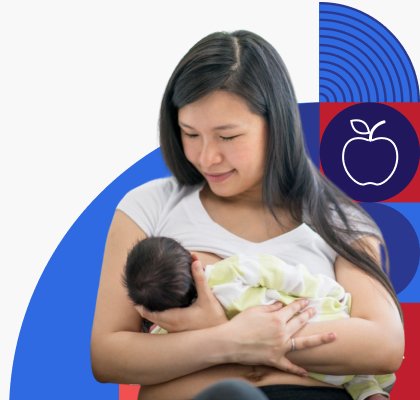
Breastfeeding has many benefits for moms and babies. For example, breastfeeding can:
- Help protect your baby from infections and illnesses, like ear infections and asthma
- Lower your risk of some diseases like type 2 diabetes, ovarian cancer, and breast cancer
Making healthy food choices while you’re breastfeeding will help you and your baby get the nutrients you both need.
Try to get most of the nutrients you need by following a healthy eating routine. Ask your doctor if you need to take a daily supplement (like a multivitamin) to get enough of nutrients.
Follow a healthy eating routine.
To get the nutrients you need while breastfeeding, follow a healthy eating routine [PDF – 1.9 MB]. Choose a mix of healthy foods you enjoy from each food group, including:
- Whole fruits — like apples, berries, oranges, mango, and bananas
- Veggies — like broccoli, sweet potatoes, beets, okra, spinach, peppers, and jicama
- Whole grains — like brown rice, millet, oatmeal, bulgur, and whole-wheat bread
- Proteins — like lean meats and chicken, eggs, seafood, beans and lentils, nuts and seeds, and tofu
- Low-fat or fat-free dairy — like milk, yogurt, cheese, lactose-free dairy, and fortified soy beverages (soy milk) or soy yogurt
- Oils — like vegetable oil, olive oil, and oils in foods like seafood, avocado, and nuts
Check the Nutrition Facts label and choose foods and drinks with less added sugars, saturated fats, and sodium (salt). Learn more about eating healthy.
Get the right amount of calories for you.
You need more calories while you’re breastfeeding than you did before you were pregnant. Use the MyPlate Plan tool to find out how many calories you need at each stage of breastfeeding. Then work with your doctor to find a healthy eating routine that works for you.
Eat 8 to 12 ounces of seafood each week.
Fish and shellfish have healthy fats that are good for you and your baby. But some seafood is high in mercury, a metal that can hurt your baby’s development. It’s a good idea to eat seafood that’s high in healthy fats but lower in mercury.
Learn more about choosing fish that’s healthy and safe to eat.
Drink plenty of fluids.
Your body needs extra fluids when you’re breastfeeding to stay hydrated. Try drinking a glass of water or other healthy beverage every time you breastfeed.
Limit drinks with caffeine and added sugars.
- Ask your doctor if caffeine is safe for you. When you’re breastfeeding, it’s usually safe to have up to 300 milligrams of caffeine a day (the amount in about 3 cups of coffee) — but your doctor may recommend less.
- Limit drinks with added sugars like sodas, sports drinks, and energy drinks.
Consider avoiding alcohol.
Not drinking alcohol is the safest option for breastfeeding mothers. If you’re thinking about drinking while breastfeeding, talk with your doctor first.
If you choose to drink alcohol, follow these safety tips.
- Drink only in moderation — for women, this means no more than 1 drink a day. In general, 1 drink is equal to a bottle of beer, a glass of wine, or a shot of liquor. But keep in mind that many drinks have much more alcohol than a standard serving. Learn more about what counts as a standard drink.
- If you’re going to have a drink, do it just after breastfeeding or pumping — not before.
- Wait at least 2 hours after having a drink to breastfeed or pump. This gives your body time to break down the alcohol so there will be less alcohol in your breast milk.
